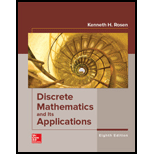
each of these relations on the set {1, 2, 3, 4}, decide whether it is reflexive, whether it is symmetric, whether it is antisymmetric, and whether it is transitive.
a) {(2, 2), (2, 3), (2, 4), (3, 2), (3, 3), (3, 4)}
b) {(1, 1), (1, 2), (2, 1), (2, 2), (3, 3), (4, 4)}
c) {(2,4),(4,2)}
d) {(1, 2), (2, 3), (3, 4)}
e) {(1, 1), (2, 2), (3, 3), (4, 4)}
f) {(1, 3), (1, 4), (2, 3), (2, 4), (3, 2), (3, 4)}
Want to see the full answer?
Check out a sample textbook solution
Chapter 9 Solutions
Discrete Mathematics and Its Applications ( 8th International Edition ) ISBN:9781260091991
Additional Math Textbook Solutions
Precalculus: Mathematics for Calculus (Standalone Book)
Calculus: Early Transcendentals (2nd Edition)
Beginning and Intermediate Algebra
Elementary & Intermediate Algebra
A First Course in Probability (10th Edition)
Finite Mathematics for Business, Economics, Life Sciences and Social Sciences
- Find all subsets of the set S={(1,3,2),(4,1,1),(2,7,3),(2,1,1)} that form a basis for R3.arrow_forwardExpress (AB)(AB) in terms of unions and intersections that involve A,A,B,andBarrow_forwardLet be a relation defined on the set of all integers by if and only if sum of and is odd. Decide whether or not is an equivalence relation. Justify your decision.arrow_forward
- Give an example of a relation R on a nonempty set A that is symmetric and transitive, but not reflexive.arrow_forwardThe binary relation {(1,1), (2,1), (2,2), (2,3), (3,1), (3,2)} on the set {1, 2, 3} is O reflexive, symmetric, and transitive transitive O antisymmetric O anstisymmetric and transitivearrow_forwardHow many symmetric relations on the set A = {1,2, 3, 4, 5, 6, 7, 8} contain the ordered pairs (2, 3), (3, 2), (4, 7), (5, 5) and (8, 7)?arrow_forward
- Determine if the relation R = {(1,3), (1,4), (2,3), (2,4), (3,4)} is reflexive, symmetric, antisymmetric, or transitive.arrow_forwardWhich relation on the set {a, b, c, d} are equivalence relations and contain (i) (b, c) and (c, d) (ii) (a, b) and (b, d)arrow_forwardCompute the complement of relation R. R={(1, 1), (5, 1), (5, 5), (6, 1), (6, 6), (7, 1), (7, 7)}arrow_forward
- Let R1 and R2 be relations on a set A = {1, 2, 3, 4}. In particular, let R, = {(1, 1), (1, 2), (2, 1), (2, 2), (2, 4), (3, 4), (4, 2), (4, 3) (4, 4)} and R2 = {(1, 2), (1, 3), (1, 4), (2, 1), (2, 3), (4, 1), (4, 2)}. Determine the following: a) Whether or not R¡ is reflexive, irreflexive, symmetric, anti-symmetric and transitive or not. b) Whether or not R2 is reflexive, irreflexive, symmetric, anti-symmetric and transitive or not. c) The relation R, ° R2. d) The relation R2 ° Rị. e) R1 U R2 f) R1 n R2 g) The reflexive, symmetric and transitive closures of both R¡ and R2.arrow_forwarda ) Let R be the relation on the set A={1,2,3,4} defined by aRb if and only if 2a>b+1. Find the matrix representing R∘R. b) Suppose that the relation R is defined on the set Z where aRb means a= ±b. Show that R is an equivalence relation.i would like to get a non handwriting answer to be easy to cope pleasearrow_forwardLet X = {a, b, c} and R={(c, b),(a, c)}. Then Check the all properties reflexive,symmetric, antisymmetric, transitive etc. Which one is true?arrow_forward
 Elements Of Modern AlgebraAlgebraISBN:9781285463230Author:Gilbert, Linda, JimmiePublisher:Cengage Learning,
Elements Of Modern AlgebraAlgebraISBN:9781285463230Author:Gilbert, Linda, JimmiePublisher:Cengage Learning, Elementary Linear Algebra (MindTap Course List)AlgebraISBN:9781305658004Author:Ron LarsonPublisher:Cengage Learning
Elementary Linear Algebra (MindTap Course List)AlgebraISBN:9781305658004Author:Ron LarsonPublisher:Cengage Learning

